United Launch Alliance’s Atlas V rocket successfully lifted off from Cape Canaveral Space Force Station in Florida, carrying Boeing’s Starliner spacecraft with NASA astronauts Butch Wilmore and Sunita Williams on board. This marks the first crewed flight of the Starliner spacecraft after several years of setbacks and delays. The launch took place at 10:52 a.m. ET, with the gumdrop-shaped capsule separating from the rocket’s Centaur upper stage to continue its journey to the International Space Station.
Boeing has faced significant challenges in getting Starliner ready for crewed missions, with approximately $1.5 billion in cost overruns and multiple delays in launching the Crew Flight Test (CFT). Previous attempts to launch the CFT were scrubbed due to issues with the Atlas V launch system, rather than with Starliner itself. However, after resolving these hardware issues, United Launch Alliance, Boeing, and NASA were able to proceed with the launch of Starliner for its first crewed test flight, marking a significant milestone in American space exploration.
The main objective of the CFT is for the crew to verify that all of Starliner’s systems are functioning as expected. During the 25-hour journey to the International Space Station and the eight-day stay aboard the station, Wilmore and Williams will conduct various tests to ensure the spacecraft’s readiness for future missions. Additionally, they will deliver supplies and equipment to the station, including a replacement pump for the urine-recycling system, before returning to Earth in the Calypso capsule.
Following the completion of the CFT, NASA and its partners will evaluate Starliner’s performance and make any necessary adjustments to the spacecraft’s design or procedures. The goal is to have Starliner certified for regular crewed flights to the International Space Station, alongside SpaceX’s Crew Dragon spacecraft. This will provide NASA with multiple options for transporting astronauts and supplies to and from orbit, enhancing the agency’s capabilities for space exploration.
The successful launch of Starliner and the upcoming evaluation of its performance highlight the collaborative efforts of NASA, Boeing, and United Launch Alliance in advancing human spaceflight. The crew’s arrival at the International Space Station will be a proud moment for NASA and its partners, as both Starliner and Crew Dragon will be present at the station simultaneously. This achievement represents a significant step forward in commercial space transportation and sets the stage for continued cooperation in space exploration.
Overall, the launch of the Starliner spacecraft with NASA astronauts aboard represents a major milestone in American space exploration, following years of setbacks and challenges. The successful mission of the CFT will pave the way for future crewed flights of the Starliner spacecraft and establish it as a key component of NASA’s space transportation capabilities. In collaboration with SpaceX’s Crew Dragon, Starliner will help usher in a new era of human spaceflight, expanding opportunities for astronauts and researchers to explore the cosmos and push the boundaries of space exploration.


